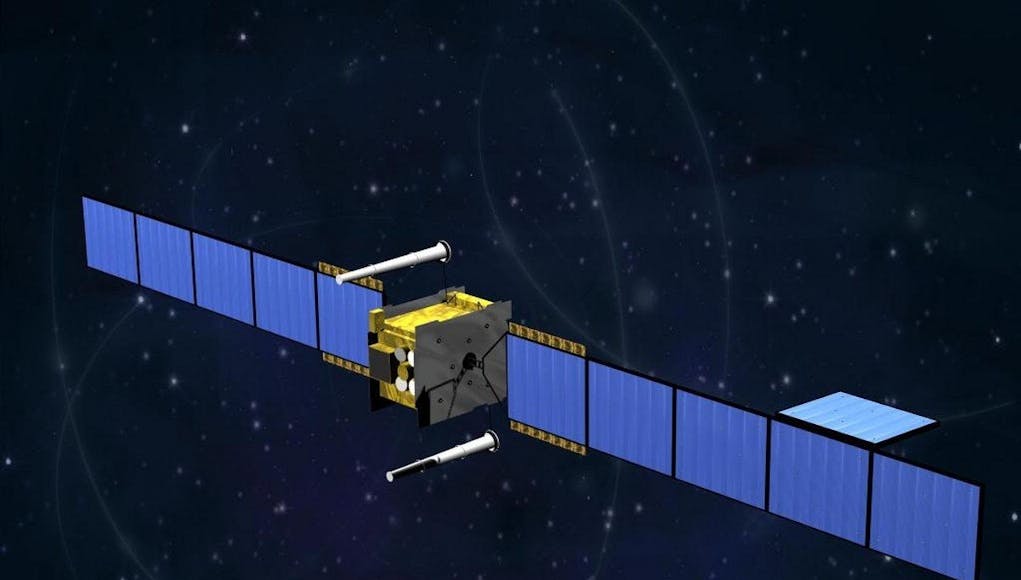Skynet is a family of commercially managed military communications satellites operated on behalf of the Ministry of Defence, which provide strategic communication services to the British Armed Forces and UK allies.
Skynet 5 is most recent generation of the family, replacing the existing Skynet 4 Stage 2 system. The satellites have been contracted via PFI to a partnership between Paradigm Secure Communications and EADS Astrium, parts of Airbus. EADS Astrium were responsible for the build and delivery of Skynet 5 satellites in orbit, whilst subsidiary company Paradigm will be responsible for provision of service to the MoD.
Paradigm have also been contracted to provide communications services to NATO using spare capacity on the satellites according to the Ministry of Defence who also say that the programme marks a change of approach in the UK from traditional defence procurement methods to a services-based contract which also includes provision of leased ground terminals, Reacher vehicles, the Satellite Communications Onboard Terminal for ships, and the associated baseband equipment.
According to Airbus:
“The Skynet 5 satellite is based on the Eurostar E3000 bus design, weighs about 4,700 kilograms (5.2 short tons), has two solar panels each about fifteen metres long, and has a power budget of five kilowatts. It has four steerable transmission dishes, and a phased-array receiver designed to allow jamming signals to be cancelled out. They will also resist attempts to disrupt them with high-powered lasers.”
Below are the technical specifications, again from Airbus:
The fleet of military X-band satellites have been specifically designed to support smaller, low powered, tactical terminals. Each Skynet 5 satellite is equipped with:
- High power 160W TWTAs on all transponders, giving 56 dBW peak EIRP in each transmit spot beam and 41 dBW peak EIRP in each global beam per transponder.
- 15 active transponders ranging in bandwidth from 20 MHz to 40 MHz
- Up to 9 UHF channels
- Multiple fully steerable downlink spot beams
- On Board Active Receive Antenna (OBARA) capable of generating multiple shaped uplink beams
- Flexible switching capability allowing connectivity between any uplink beam and at least two downlink beams
- Nuclear hardening, anti-jamming countermeasures and laser protection
Initially two Skynet 5 satellites were to be built, with insurance covering any launch loss; the MoD later decided to have a third satellite built in advance, and later still to have the third satellite launched to serve as an on-orbit spare.
Recently, satellite ‘Skynet 5A’ moved from its position over Europe, the Middle East and Africa, making Skynet services available over the eastern Asia-Pacific region, including in Australia which will also host a new ground station. An official said:
“The announcement that Airbus will be moving one of the UK’s Skynet satellites to the eastern Asia-Pacific region is clear proof of how much our relationships with our international allies matter. This is the first time that we have had a secure communications capability in the region, and shows the depth of our commitment to our allies and partners in the region, including Malaysia, in humanitarian and peacekeeping operations.”
The agreement of the British government to move the satellite is believed to be part of a broad programme of increased cooperation with Asian and Pacific allies.
Colin Paynter, head of Airbus Space and Defence, said:
“The Skynet 5 constellation consists of the world’s most powerful, nuclear hardened and protected, military X-band and UHF satellites. With the move of Skynet 5A, we will expand the availability of our premium secure MILSATCOM services to allied nations in the region who need high grade resilient and secure communications services to complement their existing systems.”












I wonder if they were all pissing themselves laughing when they called it skynet.
It’s been called Skynet since the 1960s, long before the films Jonathan.
[…] post What is Skynet? A look at Britain’s military communications satellites appeared first on UK Defence […]
Yeah. This bit though … “Skynet 5 is most recent generation of the family, replacing the existing Skynet 4” … made me wonder whether it went back as far as a Skynet 1 and, if so, when was that launched. Terminator One (“The Terminator”) came out in 1984.
Wikipedia has the answer – https://en.wikipedia.org/wiki/Skynet_(satellite)
Skynet 1 was launched on 22 November 1969 and the system first became sentient on ….. aaaarggghhhhh……
World leading capability this. Even the US buys bandwidth from us…
Yes but I can’t get beyond the name….. I’ll be back…….
Interesting. There are ground stations at Colerne, 2 at Oakhanger, and Episkopi in Cyprus with another smaller one on the Falklands, but this Australian based one planned is news to me.
Where in Oz will this be located?
DM wrote:
“Where in Oz will this be located?”
Adelaide
http://www.abc.net.au/news/2016-05-16/skynet-satellite-ground-station-opens-in-adelaide/7419042
Thank you farouk.
Lets have a Google Earth look…
It costs a fricken fortune for the bandwidth. The joys of PFI and a contract that guarantees a set amount of bandwidth at a price and anything over that at a premium.
On the plus side it has meant that HF data links using modems and digital wave forms have seen a resurgence . Some of the services that used to be sent over the SATCOM system can now be sent over HF. HF is “free” and that frees up bandwidth on the system for other uses.
SATCOM bandwidth is always an issue on a ship, you never have enough of it and always want more.
Comm links, Data Links, Int and Sigint links, CSS, Gold , Video Conferencing, Internet, DII, Welfare phones, UMMS, Maintenance lines the list goes on and on.
The DCSA control Center at the former Rudloe Manor site is an interesting visit. Sobering when you look at the bigger picture to see that the Fleet Amphib flagship at the time was not even in the top 20 priorities for satcom connection and bandwidth allocation. That position and rightly so was given to some blokes who where living and reporting from a cave in Afghan.
GOSCC. Impressive facility.
Yep, its Geek heaven.
Thanks Gunbuster. Put me right please: I was led to believe there was bags of bandwidth available on these sats. So much so that we are selling spare capacity to third parties! You suggest otherwise…
I think I am right in saying the Reaper UAV’s are another asset that uses up a huge amount of bandwidth?
The amount of Bandwidth the RN/ARMY/RAF have is set out in the contract for the supply of Satcom services. If the you want more bandwidth than what is contracted for, it comes at a premium price. The SKYNET 5 system has huge capacity and the “spare” or rather unused bandwidth is sold to other nation users. However if the RN wants more than its contracted for it has to pay for it.
So yes there is spare capacity but if the RN wants to use that capacity its going to cost…
Its the joy of having a PFI.
I wonder if anyone has actually asked Australia if they want to do this. Seems like a stretch for them on their budget much less NZ and Canada.
Would be great to see, could even pave the way for a CANZUK space program.
We can only hope Martin.
Can’t really imagine that it’s being done without OZ support. Those days are long gone. With their fears about Chinese expansionism I suspect that they were even pushing for it.
“Genisys is Skynet.” Sorry, just had to.